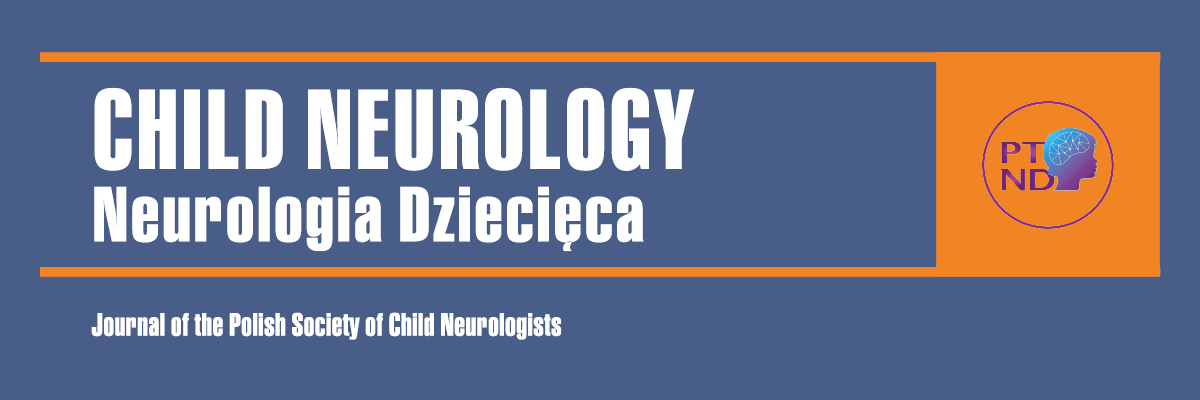Vol 33, No 61 (2023): Continuous Publishing
Review paper
Published online: 2024-06-05
Treatment of drooling in children and adolescents with neurological disorders
DOI: 10.5603/cn.98940
Neurol Dziec 2023;33(61):30-34.
Abstract
Drooling (sialorrhea) is excessive loss of saliva from the mouth. It is mainly caused by impaired swallowing of saliva. Severe drooling is a common, worrying problem in children and adolescents with neurological disorders, which has negative health and social consequences. The treatment of drooling is a complicated and long-term process that requires the appropriate cooperation of many specialists. The choice of therapy depends on child’s intelectual developement, its ability to cooperate and the cause of drooling. The most effective treatment is speech therapy. Pharmacological treatment and surgical interventions should be considered in specific cases in patients with moderate to severe drooling or patients with respiratory complications. Currently, the only registered drug for the treatment of severe sialorrhea in children and adolescents from 3 years of age with chronic neurological disorders is glycopyrronium bromide.
Keywords: droolingglycopyrronium bromide
References
- Fairhurst CBR, Cockerill H. Management of drooling in children. Arch Dis Child Educ Pract Ed. 2010; 96(1): 25–30.
- Bochenek A, Reicher M. Anatomia człowieka. PZWL, Warszawa 2007: 77–86.
- Misiowiec P, Zomkowska E, Jarmołowicz-Aniołkowska N. Instrumentalne badanie FEES w ocenie zaburzeń połykania u chorych z naczyniopochodnym uszkodzeniem OUN — wady i zalety. Logopedia. 2020; 47: 279–285.
- Hassmann-Poznańska E.: Zaburzenia wydzielania śliny (ślinotok, suchość w jamie ustnej). https://www.mp.pl/pacjent/objawy/74804,zaburzenia-wydzielania-sliny-slinotok-suchosc-w-jamie-ustnej (2.09.2023).
- Bittmann S, Luchter E, Bittmann L, et al. Current aspects of treatment options of chronic sialorrhea in children. J Clin Med Res. 2022; 14(6): 246–249.
- Riva A, Amadori E, Vari M, et al. Impact and management of drooling in children with neurological disorders: an Italian Delphi consensus. Ital J Pediatr. 2022; 48(1).
- Domaracki L, Sisson L. Decreasing drooling with oral motor stimulation in children with multiple disabilities. Am J Occup Ther. 1990; 44(8): 680–684.
- Dias B, Fernandes A, Filho HM. Sialorrhea in children with cerebral palsy. J Pediatr (Rio J). 2016; 92(6): 549–558.
- Alrefai A, Aburahma S, Khader Y. Treatment of sialorrhea in children with Cerebral Palsy: A double-blind placebo controlled trial. Clin Neurol Neurosurg. 2009; 111(1): 79–82.
- You P, Strychowsky J, Gandhi K, et al. Anticholinergic treatment for sialorrhea in children: a systematic review. Paediatr Child Health. 2021; 27(2): 82–87.
- Begley KA, Braswell L, Noritz G, et al. Salivary gland ablation: introducing an interventional radiology treatment alternative in the management of sialorrhea. Pediatr Radiol. 2020; 50(6): 869–876.
- Berweck S, Bonikowski M, Kim H, et al. Placebo-Controlled clinical trial of incobotulinumtoxina for sialorrhea in children: SIPEXI. Neurology. 2021; 97(14): e1425–e1436.
- Charakterystyka Produktu Leczniczego Sialanar. https://ec.europa.eu/health/documents/communityregister/2018/20180413140306/anx_140306_pl.pdf (2.09.2023).
- Fayoux P, Dinomais M, Shaw H, et al. Randomised, double-blind, placebo-controlled trial of glycopyrronium in children and adolescents with severe sialorrhoea and neurodisabilities: protocol of the SALIVA trial. BMJ Paediatr Open. 2023; 7(1): e001913.
- Parr J, Todhunter E, Pennington L, et al. Drooling Reduction Intervention randomised trial (DRI): comparing the efficacy and acceptability of hyoscine patches and glycopyrronium liquid on drooling in children with neurodisability. Arch Dis Child. 2017; 103(4): 371–376.
- Camp‐Bruno J, Winsberg B, Green‐Parsons A, et al. Efficacy of benztropine therapy for drooling. Dev Med Child Neurol. 2008; 31(3): 309–319.
- Reid S, Westbury C, Guzys A, et al. Anticholinergic medications for reducing drooling in children with developmental disability. Dev Med Child Neurol. 2019; 62(3): 346–353.
- Reddihough D, Johnson H, Staples M, et al. Use of benzhexol hydrochlorde to control drooling of children with cerebral palsy. Dev Med Child Neurol. 2008; 32(11): 985–989.
- Norderyd J, Graf J, Marcusson A, et al. Sublingual administration of atropine eyedrops in children with excessive drooling — a pilot study. Int J Paediatr Dent. 2015; 27(1): 22–29.
- Dias B, Fernandes A, Filho HM. Treatment of drooling with sublingual atropine sulfate in children and adolescents with cerebral palsy. Arquivos de Neuro-Psiquiatria. 2017; 75(5): 282–287.





